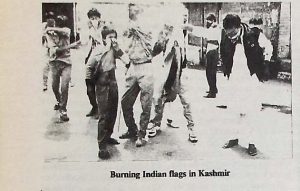

Cases of police atrocities are being reported with increasing frequency in Jammu and Kashmir. The national press and civil liberties groups appear to be unaware of this situation.
We are now used to harrowing stories of torture and faked encounters in Punjab but the national press has been sorely remiss in not reporting police atrocities in the state of Jammu and Kashmir. ‘The task is being nobly performed by the daily $Sta2The Kashmir Times edited by Ved Bhasin, a journalist highly respected for his integrity and fearlessness.
The issue of June 10, 1989 carries a report from the paper’s Jammu correspondent on the death of Sarabjit Singh in police custody. He was one of the two alleged terrorists arrested in the evening of June 7 and “was allegedly meted out tortorous (sic) death in the police custody though the interrogators claimed that he committed suicide, He was brought dead to the hospital where his postmortem was conducted.
The correspondent adds “Initial investigations revealed that the youth was tortured to death,” with multiple injuries on his body.” The government alleged that he had consumed some poisonous substance as a result of which he died. A magisterial inquiry was ordered. The truth will be known.
The father of the deceased, Sher Singh, alleged tortured and said that the body was blackened by it. It bore marks of multiple injuries and his knees, chest and legs had the signs of severe torture. “Isn’t that enough proof of what the police had done to my son?
In the Kashmir valley similar charges have been heard. On June 5 the People’s Conference chairman Abdul Ghani Lone alleged the systematic practice of torture in interrogation centres, according to The Kashmir Times Srinagar correspondent Jafar Meraj who bears the torch of his late uncle Shamim Ahmed Shamim. Lone urged the central and state governments to find some political solution to the problems facing the people instead of resorting to brutal methods.
The correspondent reported:
Lone charged the government with having hatched a conspiracy to make the arrested youth physical and mental wrecks by subjecting them to unprecedented physical and mental torture, both.
He said that most of the arrested youth had fallen prey to one or the other disease and in this connection cited several examples, Habibullah Mir of Lonehari village in Handwara had developed heart trouble in the interrogation centre and was lying in a critical condition in Soura hosptial. Ali Mohammed Mandoo of Gonipora in Handwara presently lodged in Hiranagar jail had lost his mental balance and had virtually tumed mad. Both the legs of Abdul Ahad Butt of Wadipora Handwara had been broken in the interrogation centre and he was now fast losing his sight also. Mehmood Ahmad Sagar had developed heart trouble and none of his family members was allowed to see him nor was he being given any medical treatment.
Mr. Lone also doubted the government’s claim about the alleged escape from police custody of the two prominent militants, Mohammad Ahsan Dar and Mohammad Nayeem BVuttand said there were apprehensions in the minds of the people here that both had been physically liquidated by the police.
The charges are as grave as they are specific. If the people of the valley are not to feel alienated from the rest of the country a citizen’s committee set up by the PUCL or PUDR or jointly by both should visit the state and report on the civil rights situation in both the valley as well as in Jammu.
Consider another detailed report in The Kashmir Times of June 2 by Arun Sharma:
All the persons arrested from time to time in the state on the charge of being ‘enemy. agent’ have been awaiting judicial trial for the last several years.
Even after several years of their arrest the police has yet to present challans against them in the competent courts, The accused in almost all such cases have, however, been bailed out by the courts.
Though released on bail, a number of the alleged ‘enemy agents’ who claim themselves to be ‘innocent’ are awaiting judicial trial of their cases to remove the stigma. However, many others are reported to have crossed over to Pakistan, after securing bail from a competent court and yet the police appears to be in no mood for presenting challans against the persons to whom it had once accused of being ‘enemy agents’.
Such is the sordid state of affairs of the law and order agency in the state.
Sharma’s dispatch is detailed and sets out the facts fairly enough. The net result he says is that not one alleged “enemy agent’ has so far been convicted by the court either for want of police challan or prosecution evidence. Meanwhile, no doubt the accused languished in jail till they secured bail. What happens in jails, we all know.
Ina case decided on August 11, 1988 (Mohan Lal Sharma ys State of Uttar Pradesh) by the Supreme Court, the chief justice RS. Pathak remarked “we may note that we are gravely concerned at the increasing number of deaths which are reported of persons: detained in police lockups.” The court directed the CBI to make “a thorough and detailed investigation.” It rejected the magistrate’s report as unsatisfactory. The court acted on a telegram from the petitioner saying that his son Sanjay aged 17 years old, was arrested by the Agra police on October 10, 1986 in the morning. He was not produced before a magistrate the next day as the constitution requires. He alleged that Sanjay was murdered by the police in the lockup.
Article extracted from this publication >> September 29, 1989